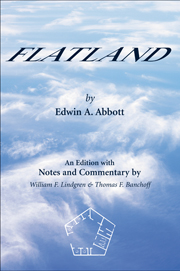Book contents
- Frontmatter
- Contents
- Acknowledgments
- Introduction
- Flatland with Notes and Commentary
- Part I This World
- 1 Of the Nature of Flatland
- 2 Of the Climate and Houses in Flatland
- 3 Concerning the Inhabitants of Flatland
- 4 Concerning the Women
- 5 Of our Methods of Recognizing one another
- 6 Of Recognition by Sight
- 7 Concerning Irregular Figures
- 8 Of the Ancient Practice of Painting
- 9 Of the Universal Colour Bill
- 10 Of the Suppression of the Chromatic Sedition
- 11 Concerning our Priests
- 12 Of the Doctrine of our Priests
- Part II Other Worlds
- Epilogue by the Editor
- Continued Notes
- Appendix A Critical Reaction to Flatland
- Appendix B The Life and Work of Edwin Abbott Abbott
- Recommended Reading
- References
- Index of Defined Words
- Index
5 - Of our Methods of Recognizing one another
Published online by Cambridge University Press: 05 August 2013
- Frontmatter
- Contents
- Acknowledgments
- Introduction
- Flatland with Notes and Commentary
- Part I This World
- 1 Of the Nature of Flatland
- 2 Of the Climate and Houses in Flatland
- 3 Concerning the Inhabitants of Flatland
- 4 Concerning the Women
- 5 Of our Methods of Recognizing one another
- 6 Of Recognition by Sight
- 7 Concerning Irregular Figures
- 8 Of the Ancient Practice of Painting
- 9 Of the Universal Colour Bill
- 10 Of the Suppression of the Chromatic Sedition
- 11 Concerning our Priests
- 12 Of the Doctrine of our Priests
- Part II Other Worlds
- Epilogue by the Editor
- Continued Notes
- Appendix A Critical Reaction to Flatland
- Appendix B The Life and Work of Edwin Abbott Abbott
- Recommended Reading
- References
- Index of Defined Words
- Index
Summary
You, who are blessed with shade as well as light, you who are gifted with two eyes, endowed with a knowledge of perspective, and charmed with the enjoyment of various colours, you, who can actually see an angle, and contemplate the complete circumference of a Circle in the happy region of the Three Dimensions – how shall I make clear to you the extreme difficulty which we in Flatland experience in recognizing one another's configuration?
Recall what I told you above. All beings in Flatland, animate or inanimate, no matter what their form, present to our view the same, or nearly the same, appearance, viz. that of a straight Line. How then can one be distinguished from another, where all appear the same?
The answer is threefold. The first means of recognition is the sense of hearing; which with us is far more highly developed than with you, and which enables us not only to distinguish by the voice our personal friends, but even to discriminate between different classes, at least so far as concerns the three lowest orders, the Equilateral, the Square, and the Pentagon – for of the Isosceles I take no account. But as we ascend in the social scale, the process of discriminating and being discriminated by hearing increases in difficulty, partly because voices are assimilated, partly because the faculty of voice-discrimination is a plebeian virtue not much developed among the Aristocracy. And wherever there is any danger of imposture we cannot trust to this method.
- Type
- Chapter
- Information
- FlatlandAn Edition with Notes and Commentary, pp. 44 - 54Publisher: Cambridge University PressPrint publication year: 2009



